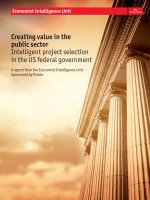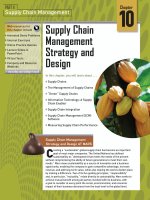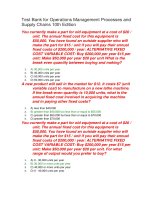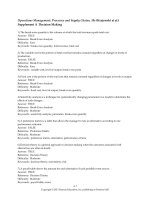Lecture Operations management: Creating value along the supply chain (Canadian edition) - Chapter 10
Bạn đang xem bản rút gọn của tài liệu. Xem và tải ngay bản đầy đủ của tài liệu tại đây (1.31 MB, 38 trang )
OPERATIONS MANAGEMENT:
Creating Value Along the Supply Chain,
Canadian Edition
Robert S. Russell, Bernard W. Taylor III, Ignacio Castillo, Navneet Vidyarthi
§
CHAPTER 10
Supply Chain Management:
Strategy and Design
1
§
Learning Objectives
Define supply chains with respect to both
manufacturing and services.
Explain characteristics and management strategies of
the modern supply chain.
Discuss sustainable supply chain practices and how
they relate to quality management.
Discuss information technologies currently avail- able
for supply chain management.
Provide an overview of the four areas where
information technology assists with supply chain
integration.
Discuss tools for monitoring supply chain performance
and calculate key performance indicators.
10-2
§
Lecture Outline
The Management of Supply Chains
Green Supply Chains
Information Technology: A Supply Chain
Enabler
Supply Chain Integration
Supply Chain Management (SCM)
Software
Measuring Supply Chain Performance
10-3
§
Supply Chains
•
•
All facilities, functions, and activities associated
with flow and transformation of goods and
services from raw materials to customer, as well
as the associated information flows
An integrated group of processes to “source,”
“make,” and “deliver” products
10-4
§
The Supply Chain – Figure10.1
10-5
§
Supply Chain for Denim Jeans
Figure 10.2a
10-6
§
Supply Chain for Denim Jeans (cont.)
Figure 10.2b
10-7
§
Supply Chain Processes
10-8
§
Supply Chain for Service Providers
More difficult than manufacturing
Does not focus on the flow of physical goods
Focuses on human resources and support
services
More compact and less extended
10-9
§
Value Chains
Value chain
every step from raw materials to the eventual end user
ultimate goal is delivery of maximum value to the end
user
Supply chain
activities that get raw materials and subassemblies into
manufacturing operation
ultimate goal is same as that of value chain
10-10
§
Value Chains
Demand chain
increase value for any part or all of chain
Terms are used interchangeably
Value
creation of value for customer is important aspect of
supply chain management
10-11
§
Supply Chain Management (SCM)
Managing flow of information through supply chain
in order to attain the level of synchronization that
will make it more responsive to customer needs
while lowering costs
Keys to effective SCM
information
communication
cooperation
trust
10-12
§
Supply Chain
Uncertainty and Inventory
A major objective of SCM:
respond to uncertainty in customer demand without
creating costly excess inventory
Negative effects of uncertainty
lateness
incomplete orders
Inventory
insurance against supply chain uncertainty
10-13
§
Supply Chain
Uncertainty and Inventory
Factors that contribute to uncertainty
inaccurate demand forecasting
long variable lead times
late deliveries
incomplete shipments
product changes
batch ordering
price fluctuations and discounts
inflated orders
10-14
§
Bullwhip Effect
Occurs when slight demand variability is magnified
as information moves back upstream
10-15
§
Risk Pooling
Risks are aggregated to reduce the impact of
individual risks
Combine inventories from multiple locations into one
Reduce parts and product variability, thereby reducing
the number of product components
Create flexible capacity
10-16
§
“Green” Supply Chains
Sustainability
Meeting present needs without compromising the
ability of future generations to meet their needs
Sustaining human and social resources
It can be cost effective and profitable
Can provide impetus for product and process
innovations
Impetus comes from downstream in the supply
chain and moves upstream to suppliers
10-17
§
Sustainability and Quality Management
Reducing waste through quality programs helps
achieve sustainability goals
Improving fuel efficiency of vehicles
Telecommuting
Eco-friendly packing materials
Energy-efficient facilities
10-18
§
Information Technology:
A Supply Chain Enabler
Information links all aspects of supply chain
E-business
replacement of physical business processes with
electronic ones
Electronic data interchange (EDI)
a computer-to-computer exchange of business
documents
Bar code and point-of-sale
data creates an instantaneous computer record of a sale
10-19
§
IT: Supply Chain Enabler
Radio frequency identification (RFID)
technology can send product data from an item to a
reader via radio waves
Internet
allows companies to communicate with suppliers,
customers, shippers and other businesses around the
world instantaneously
Build-to-order (BTO)
direct-sell-to-customers model via the Internet; extensive
communication with suppliers and customer
10-20
§
Supply Chain Enablers
10-21
§
E-Business & Supply Chain
Management
Savings due to lower transaction costs
Reduction of intermediary roles
Shorter supply chain response times
Wider presence and increased visibility
Greater choices & more info for customers
Improved service
Collection & analysis of huge amounts of customer
data & preferences
Access to global markets, suppliers & distribution
channels
10-22
§
Electronic Data Interchange
Computer-to-computer exchange of documents in
a standard format
Purchasing, shipping and receiving
Improve customer service
Reduce paperwork
Increase productivity
Improve billing and cost efficiency
Reduce bullwhip effect through information sharing
10-23
§
Bar Codes
Automated data collection system
Bar code contains identifying information
Provide instantaneous tracking information
Checkout scanners create point-of-sale data
Update inventory records
Identify trends
Order material
Schedule orders
Plan deliveries
10-24
§
Radio Frequency Identification (RFID)
Use radio waves to transfer data from chip to a
reader
Provides complete visibility of product location
Continuous inventory monitoring
Reduce labor to manage inventory
Reduce inventory costs
RFID is not standardized yet
Difficult to track between systems
10-25
§







